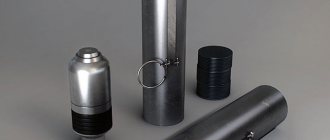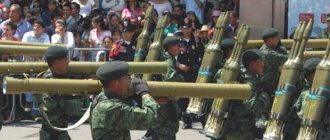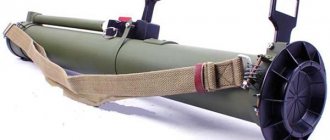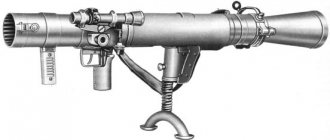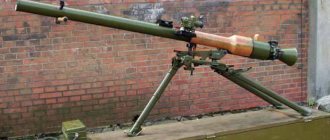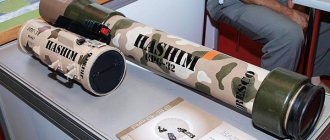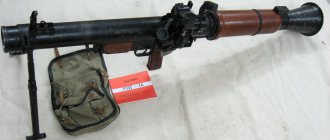AT4/M136 disposable anti-tank grenade launcher (Sweden - USA)
Disposable AT4 anti-tank grenade launcher and a grenade for it in the “in flight” position.
Disposable AT4/M136 anti-tank grenade launcher of American production, equipped with a night sight on a special quick-release bracket.
AT4 grenade launcher in battle.
Caliber
: 84 mm
Type
: recoilless
Length
: 1040 mm
Weight
: 7.5 kg
Effective firing range
: up to 150 m against moving targets, up to 300 meters against stationary
targets Armor penetration
: more than 500 mm
The AT4 anti-tank disposable grenade launcher is a joint development of the Swedish company SAAB Bofors Dynamics and the American ATK corporation. Conceptually, the AT4 is a development of the American single-use rocket-propelled grenade launcher M72 LAW, but it is based on the principles and, in part, ammunition developed in Sweden for the Carl Gustaf recoilless grenade launcher. Currently, the AT4 is in service in the United States under the designation M136 LAW, in Sweden and also In a number of countries, in addition, improved versions of AT4 are being developed.
The AT4 is a disposable recoilless launcher with an unrifled barrel. The barrels are loaded at the factory, and after firing the empty barrel is thrown away. The main type of equipment is an 84mm caliber anti-tank cumulative grenade, in the tail section of which there is a folding stabilizer and a tracer. In the barrel behind the grenade there is an expelling powder charge; on the front and back sides the barrel is closed with plastic covers that are knocked out at the moment of firing. When firing from the conventional AT-4 variant, a dangerous zone more than 20 meters deep is formed behind the shooter. For shooting from enclosed spaces, the AT4-CS variant has been developed, in which a countermass is located behind the arching charge in the barrel - a small amount of non-freezing, non-flammable liquid in a destructible container. At the moment of firing from the AT4-CS, the liquid is partly ejected from the barrel back in the form of splashes, and partly evaporates, significantly reducing the exhaust of powder gases. The trigger mechanism is mechanical, requiring manual cocking before firing, with the possibility of removing it from combat cocking or setting the manual safety on combat cocking. The sights are folding, and in the stowed position they are closed with sliding covers. and include a diopter rear sight and front sight. The sight is set at a range of 200 meters. In the USA, special brackets have been developed that allow you to quickly install optical or night sights on the AT4/M136 body. In addition to the main version of the HEAT equipment with a cumulative anti-tank grenade, AT4 variants with a warhead of the HEDP type - armor-piercing fragmentation action - are produced. All 84mm warhead variants for the AT4 are analogues of the corresponding warheads for the 84mm Carl Gustaf grenade launcher.
Sliding gates with operator An Motors ASL500
I begin to move from the general view of the gate to the button for registering new key fobs.
An-Motors ASL automation for sliding gates.
As you can see, access is free.
Sliding gate drive - An Motors ASL500.
The drive unit is covered with a plastic cap. At the top you can see the inscription: An Motors.
Side view of ASL 500. Nameplate and casing mounting screws.
There is a data plate on the side. The model of this device is ASL 500. And most importantly, in front of you are the cross screws that secure the cap. You need to slightly unscrew the 4 screws on both sides and remove it.
ASL500 operator for sliding gates, without casing. Control module at the top. Preparing to program the AT-4 key fob.
A control board is attached to the top of the drive unit.
“Learn” button on the MCSL-1.1 board for programming AT-4 remote controls. ASL500 operator for sliding gates.
Here is the MCSL-1.1 control unit. The arrow indicates the “Learn” button. Translated: “to teach.” With its help, a new key fob is prescribed.
About copying the AT-4 remote control without access to the Learn button
Ordinary situation. You have a valid key fob and need another one: for family, good friends, just as a spare. The drive can be in an iron frame, under lock and key. But I want to do everything myself, without turning to anyone. There is an exit. It is necessary to use Apollo Fix duplicators, which copy the constant code at 433.92 MHz.
It is possible to duplicate the An-Motors AT-4 remote control on Apollo Fix (left).
Option with additional receiver An-Motors AR-1-500
Alutech has made the memory of the MCSL1.1 block (for sliding gates) for only 20 subscribers . For expansion, an external receiver AR-1-500 is available for 500 subscribers.
An additional receiver An Motors AR-1-500 with memory for 500 subscribers. Compatible with AT-4 key fobs.
Often, when you remove the drive cover, you will see a black plastic box with the inscription AR-1-500, as in the photo. This is an additional receiver.
- Dimensions 60*40*28 mm.
- Memory - 500 key fobs.
- Wire antenna - 16 cm.
The recording procedure is according to the instructions given above. Also through the “LEARN” button. Indicated by a white circle.
- Press and hold the white circle for 1-2 seconds. The LED indicator will light up.
- Press any button on the AT-4 key fob twice. The LED indicator will blink several times. The keychain is ready for use. You can check.
Any button is registered. If you then record another one, the previous one will stop working.
Operating countries
- Argentina: [5]
- Brazil[6]
- Great Britain: small quantities of AT4 and missiles for it have been purchased. [1]
- Venezuela: AT4 has been in use since the 1980s. [6][7]
- Georgia[6]
- Denmark: Designated PVV M/95
(
P
anser
v
ærns
v
åben
M
odel 19
95
). [8]
Ireland
: Designated SRAAW
(
Short
Range
A
nti
Armour W
eapon) by the Irish Defense Forces
. [9]- Kazakhstan[6]
- Kyrgyzstan[6]
- Latvia[10]
- Lebanon: Approximately 1,000 purchased. [eleven]
- Lithuania: Lithuanian Armed Forces. [12]
- Netherlands[13]
- Poland[14]
- USA: at the beginning of 1986, a batch of 55 thousand grenade launchers for ground forces was purchased in Sweden [15], in 1987, under the name M136 AT4,
it was adopted by the US Marine Corps and US ground forces [16] Manufactured under license, more than 300 thousand produced . PC. [1] - Republic of China[6]
- Uzbekistan[6]
- Ukraine[6]
- France: Under the designation ABL
(
A
nti
B
lindé
L
éger). [17] - Croatia[6]
- Sweden[6]
- Estonia[18]
Is it true?
The above is a kind of safety standard. In practice, the guys successfully use various types of RPGs when they themselves are in any buildings.
Of course, in this situation you can get shot in the back, but this happens extremely rarely. So, it’s a little crazy and nothing more.
It is much more important when firing an RPG while in a room to wear special headphones
. Indoors, the grenade comes out of this weapon with an increased roar.
Is it true?
The above is a kind of safety standard. In practice, the guys successfully use various types of RPGs when they themselves are in any buildings.
Of course, in this situation you can get shot in the back, but this happens extremely rarely. So, it’s a little crazy and nothing more.
It is much more important when firing an RPG while in a room to wear special headphones
. Indoors, the grenade comes out of this weapon with an increased roar.
Registering AT-4 remote controls to the MCSL-1.1 module receiver
Instructions
- Press the “Learn” button (see photo above) for 1-2 seconds. Nearby, on the board, the “LR” LED will light up.
- Press any button on the AT-4 remote control twice. The “LR” LED will go out and then blink several times. The button is registered. You can check.
It is recommended to turn off the MCSL 1.1 module antenna when recording. Connector "X4". On the board at the top left. I didn't turn off the antenna. The recording worked.
Attention
Carefully! If you hold down the “Learn” button for more than 8 seconds, the memory will be completely cleared. All remote controls will stop working.
M72 LAW - M72 LAW
The M72 LAW
(Light Anti-Tank Weapon, also known as the Light Armor-Piercing Weapon or
LAW
, and also
LAWS
: Light Armor-Piercing Weapon System) is a portable, single-shot 66 mm unguided anti-tank weapon. The solid rocket propulsion system was developed at the newly formed Rohm and Haas Research Laboratory at Redstone Arsenal in 1959, and the complete system was developed by Paul W. Choate, Charles B. Weeks, Frank A. Spinale, and others in Norris Thermador's East Hessian Division . American weapons production began by Hesse-Eastern in 1963 and was discontinued by 1983; it is currently manufactured by Nammo Raufoss AS in Norway and their subsidiary Nammo Talley, Inc. in Arizona.
In early 1963, the M72 LAW was adopted by the US Army and US Marine Corps as their primary individual infantry anti-tank weapon, replacing the M31 HEAT rifle grenade and the M20A1 "Super Bazooka" in the US Army. It was subsequently adopted by the United States Air Force for use in air defense and anti-tank defense in air base defense.
In the early 1980s, the M72 was to be replaced by the FGR-17 Viper. However, this program was canceled by Congress and the M136 AT4 was adopted in its place. At that time, its closest analogues were the Swedish Pskott m/68 (Miniman) and the French SARPAC.
Background
The increased importance of tanks and other armored vehicles in World War II created a need for portable infantry weapons to combat them. The first to be used (with limited success) were Molotov cocktails, flamethrowers, backpack charges, sworn land mines, and specially designed hollow magnetic charges. All this had to be used within a few meters of the target, which was difficult and dangerous.
The US Army introduced the bazooka, the first rocket-propelled grenade launcher. Despite early problems, it was a success and was copied by other countries.
However, the bazooka had its drawbacks. Large and easily damaged, it required a well-trained crew of two. Germany developed a one-man alternative, the Panzerfaust, with single-shot launchers that were cheap and did not require special training. As a result, they were regularly issued to Volkssturm militia regiments. They were very effective against tanks in the final days of World War II.
The M72 LAW is a combination of two WWII weapons. The basic principle is a miniature bazooka, and its light weight and cheapness rival the Panzerfaust.

